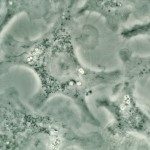Link to Pubmed [PMID] – 22438397
J. Infect. Dis. 2012 Apr;205(8):1268-77
Aspergillus terreus is emerging as a causative agent of life-threatening invasive aspergillosis. Prognosis for affected patients is often worse than for A. fumigatus infections. To study A. terreus-mediated disease, we developed 3 infection models. In embryonated hen’s eggs and leucopenic mice, the outcome of invasive aspergillosis was similar to that described for A. fumigatus. However, 10(2)- and 10(3)-fold higher conidia concentrations were required for 100% lethality. In corticosteroid-treated mice, only 50% mortality was observed, although bioluminescence imaging revealed transient disease in all infected animals. In surviving animals, we observed persistence of ungerminated but viable conidia. Cytokine levels in these mice were comparable to uninfected controls. In contrast to A. fumigatus infections, all mice infected with A. terreus developed fatty liver degeneration, suggesting the production of toxic secondary metabolites. Thus, at least in mice, persistence and subclinical liver damage are unique features of A. terreus infections.
